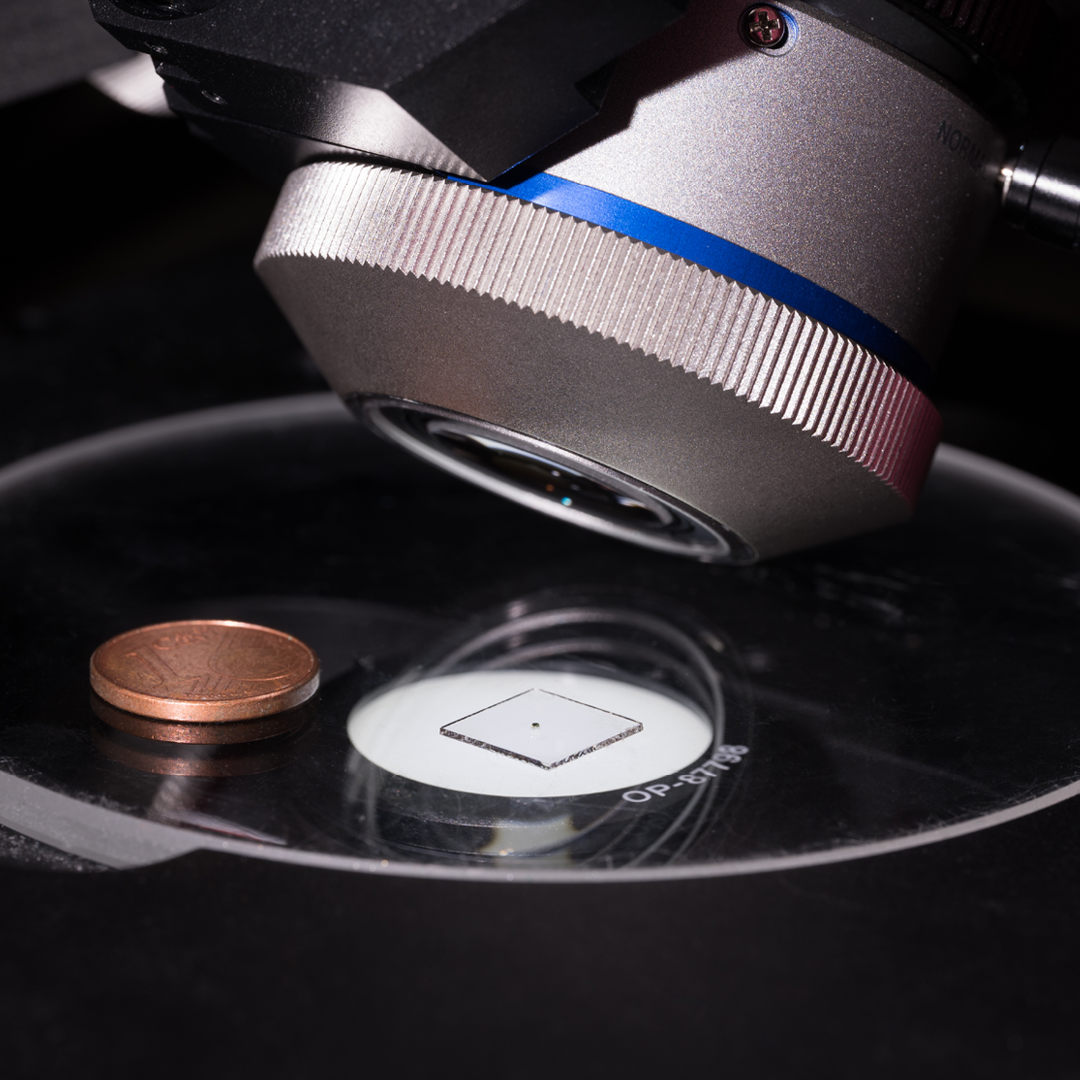Reviewed by Alex SmithApr 29 2022
A new method to apply antireflective (AR) coatings to 3D printed multi-lens systems that are as tiny as 600 μm in diameter has been developed by scientists. These coatings are crucial for producing sophisticated 3D printed systems that comprise multiple microlenses, as they can aid in decreasing light losses owing to reflection.
 The researchers used a microscope to acquire tilted-view images of a 600 µm-diameter doublet lens system 3D printed on a 1 × 1 cm² glass slide. The doublet lens system is visible as the small dot in the center of the glass slide. The coin is included for scale. Image Credit: Moritz Flöss, University of Stuttgart.
The researchers used a microscope to acquire tilted-view images of a 600 µm-diameter doublet lens system 3D printed on a 1 × 1 cm² glass slide. The doublet lens system is visible as the small dot in the center of the glass slide. The coin is included for scale. Image Credit: Moritz Flöss, University of Stuttgart.
Our new method will benefit any 3D printed complex optical system that uses multiple lenses. However, it is especially useful for applications such as miniature fiber endoscopes, which require high-quality optics and are used for imaging under less-than-ideal lighting conditions.
Harald Giessen, Research Team Leader, University of Stuttgart
Large lenses, such as the ones employed in a camera, are coated prior to being assembled in a device. For 3D printed lenses that are below 1 mm wide, traditional coating techniques like sputtering cannot be employed. This is because the whole lens system is usually printed in a single step, forming undercuts and hard-to-reach hollow openings.
The scientists elaborate on their novel low-temperature thermal atomic layer deposition (ALD) technique that is well-suited to 3D printed polymer materials in the journal Optical Materials Fast.
It could be employed to coat all the lens surfaces of a complex system simultaneously, despite having a structure with undercuts and hollow parts. The novel method can also be employed to produce other thin-film systems, like chromatic filters, directly onto 3D printed micro-optics.
We applied ALD to the fabrication of antireflection coatings for 3D printed complex micro-optics for the first time. This approach could be used to make new kinds of extremely thin endoscopic devices that might enable novel ways of diagnosing—and perhaps even treating—disease. It could also be used to make miniature sensor systems for autonomous vehicles or high-quality miniature optics for augmented/virtual reality devices such as goggles.
Simon Ristok, Study First Author, University of Stuttgart
Getting Rid of Reflection
At each lens-air interface, a small amount of light is lost due to reflection in an optical system. Antireflection coatings can be significant as such losses can begin to add up. The lens system’s imaging quality can also be impacted by such reflections.
We have been working on 3D printed micro-optics for several years and always strive to improve and optimize our fabrication process. It was a logical next step to add AR coatings to our optical systems to improve the imaging quality of complex lens systems.
Harald Giessen, Research Team Leader, University of Stuttgart
Even though ALD could be utilized to apply AR coatings, it usually needs high temperatures that are capable of melting the materials that are used to 3D print complex micro-optical systems. Typically, 3D printed lenses are steady up to around 200 °C; hence, the scientists designed an ALD process that operates at 150 °C.
The 3D printed lens system is exposed to a gas, containing the antireflective coating’s molecular building blocks, during ALD. To produce a homogeneous thin layer on all exposed lens surfaces, the gas molecules can mobilize freely through the hollow parts of the 3D printed structure.
The material properties and thickness can be adjusted to create sequences of low and high refractive index coatings or other AR coating designs by including successive layers and changing the precursor gas.
Assessing the Coatings
The scientists defined their ALD coatings on 3D printed samples and discovered that the coatings reduced flat substrates’ broadband reflectivity in visible wavelengths to less than 1%. They also assessed the ALD coating technique using a 3D printed double-lens imaging system, which was 600 μm wide.
“To print the double-lens system, we used a Nanoscribe Quantum X microfabrication system that enables unprecedented surface smoothness for 3D printed lenses. We showed that our ALD coatings significantly reduced reflectivity and, conversely, enhanced transmission for this multi-lens system,” stated Ristok.
The scientists are planning to employ their ALD method to form advanced coating designs with multiple layers, which can reduce reflection losses even further for particular wavelengths. They state that both ALD deposition of AR coatings and 3D printing of micro-optics are compatible for quick prototyping or small-series production.
They also claim that decreasing the processing time can make both approaches ideal for larger-scale production. Also, they are open to working alongside scientists who would be willing to apply AR coatings to their 3D printed optical systems.